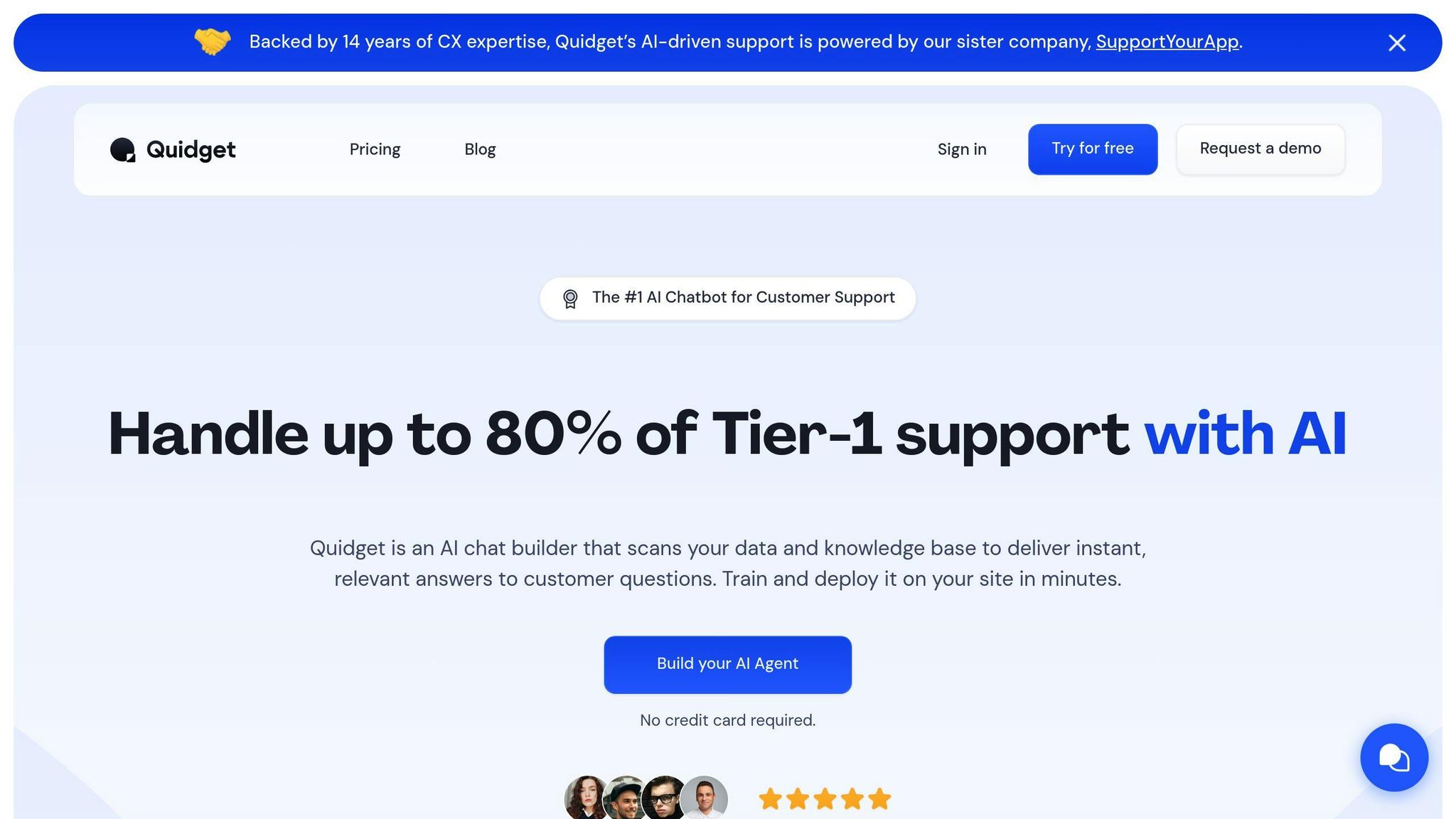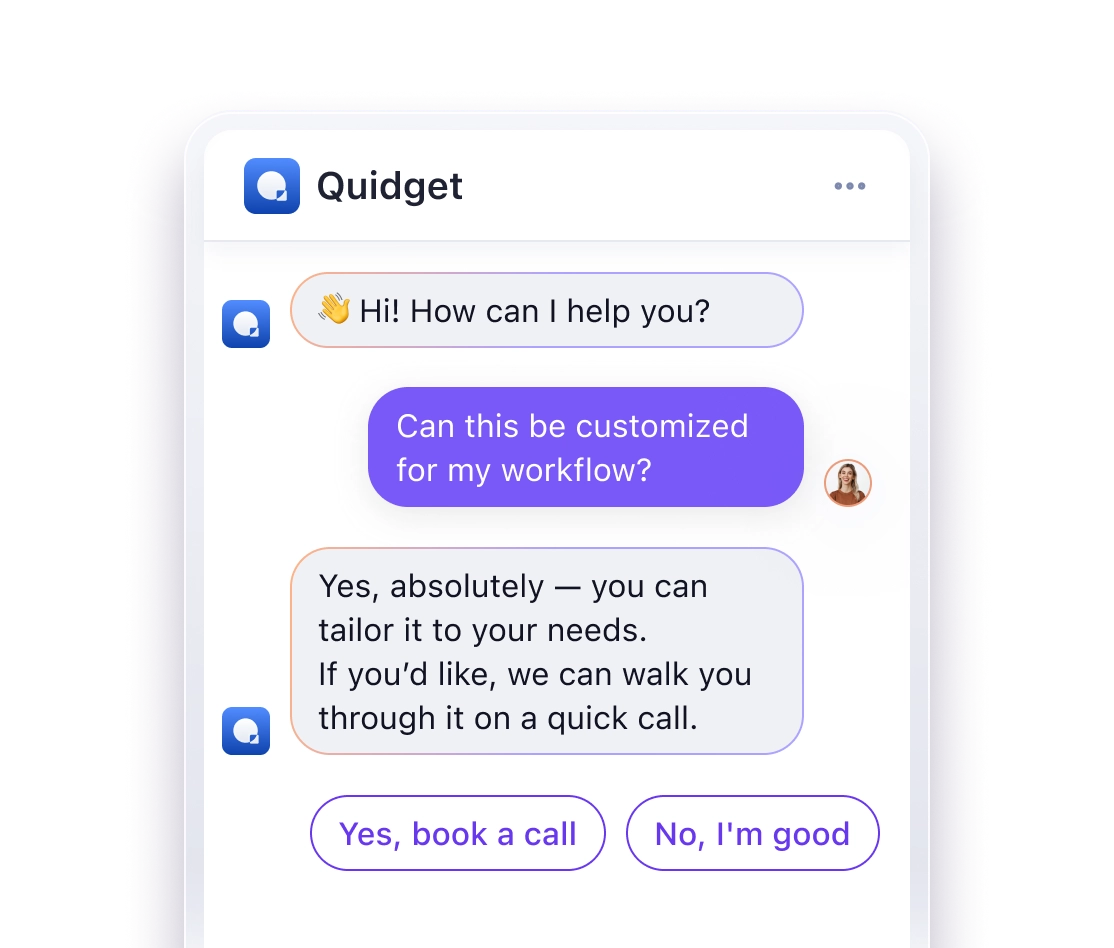AI chatbots are revolutionizing customer support by offering faster, more efficient, and cost-effective solutions. Here’s what they bring to the table:
- Handle 80% of routine inquiries: Chatbots free up human agents for complex tasks.
- 24/7 availability: Instant support in over 80 languages, even during holidays.
- Cost savings: U.S. businesses save $23 billion annually by automating customer service.
- Faster responses: Chatbots are 3x quicker than humans, boosting customer satisfaction by 24%.
- Data insights: Analyze customer behavior to refine services and improve operations.
With tools like Quidget, businesses can integrate chatbots seamlessly into their workflows, scaling operations while maintaining high-quality support. Whether you’re a small business or a large enterprise, AI chatbots are reshaping how companies interact with customers, combining efficiency with a human touch.
3 Benefits of virtual assistants for Customer Service
Benefits of Using AI Chatbots in Customer Support
AI chatbots are changing the game in customer support, offering a range of advantages for businesses of all sizes. Here’s a closer look at why they’re becoming a must-have tool for modern customer service.
Always-On Support
AI chatbots are available 24/7, providing instant help no matter the time or day. Whether it’s late at night or during a holiday, customers can get the assistance they need. Tools like Quidget take this further by supporting over 80 languages, making it easier to connect with a global audience. This constant availability helps businesses stay ahead in a fast-moving, customer-driven world.
Managing Routine Questions
Chatbots are great at handling repetitive, straightforward questions, which allows support teams to focus on more challenging problems. They can tackle up to 80% of common customer queries automatically. In fact, 94% of customer service professionals say their productivity improved after adopting chatbots [7].
Cost Savings and Scalability
By automating routine tasks, AI chatbots help cut costs while scaling up during busy periods. They respond to questions three times faster than human agents, reducing the need for additional staff during peak times. This efficiency saves U.S. businesses an estimated $11 billion and 2.5 billion hours every year [2].
Understanding Customer Needs
AI chatbots collect valuable data about customer behavior, such as common problems, frequently asked questions, and interaction trends. This information helps businesses refine their services and products. According to research, 91% of companies report being satisfied with the insights gained from AI-driven analytics [2].
With tools like Quidget, businesses can analyze customer interactions and use the data to improve their support strategies. These insights not only enhance customer satisfaction but also integrate smoothly with existing systems, setting the stage for more efficient operations, as discussed in the next section.
How AI Chatbots Work and Connect with Your Business
AI chatbots have come a long way, evolving from basic tools to advanced systems that reshape customer support. Here’s a closer look at how they function and align with business operations.
Understanding Customer Questions with NLP
AI chatbots rely on Natural Language Processing (NLP) to make sense of customer questions. By analyzing key phrases and intent, they can provide accurate answers, even when queries are phrased differently—like "Where’s my order?" versus "What’s the status of my package?"
"AI-powered chatbots are sophisticated software applications designed to simulate human conversation. These chatbots utilize Natural Language Processing (NLP) to interpret and process human language, enabling them to understand the context and nuances of customer inquiries." [1]
Learning and Improving Over Time
With machine learning, modern chatbots get smarter after every interaction. They spot patterns in customer questions, fine-tune responses, and pick up industry-specific jargon. Over time, this leads to quicker, more accurate answers and a better overall experience for users.
Connecting to Your Business Tools
What makes AI chatbots especially effective is their ability to integrate with your existing systems. They link up with CRMs, e-commerce platforms, knowledge bases, and messaging apps. Suppose a customer asks about their recent order—the chatbot can instantly pull up shipping details, check the status, and provide tracking info in seconds.
These features, as seen in tools like Quidget, show how AI chatbots can transform customer support and make it more efficient.
Case Study: How Quidget Improves Customer Support

Overview of Quidget
Quidget is a no-code AI chatbot built for small and medium-sized businesses. It automates up to 80% of routine customer inquiries across more than 80 languages. The tool integrates seamlessly with platforms like Shopify, WordPress, and Webflow, making deployment fast and straightforward. Quidget highlights how AI chatbots are transforming customer service by providing advanced solutions to businesses of all sizes.
Features That Make Quidget Stand Out
Quidget offers several standout features, including:
- Multilingual support for global reach
- Instant responses to customer queries
- Integration with popular platforms like Shopify and WordPress
- Smart escalation to human agents when needed
- A no-code setup that ensures quick and hassle-free deployment
"Quidget is designed for small and medium-sized businesses that want to automate customer service with AI to save time, money and human resources." [6]
Saving Time and Cutting Costs with Quidget
By automating routine inquiries, Quidget helps support teams save an average of 3 hours per agent each day while cutting costs by up to 90%. Businesses using Quidget report faster resolution times and an increase in customer satisfaction, with 90% noting improved complaint resolution after adopting the tool [2]. These time and cost savings allow teams to focus on more strategic tasks, leaving human agents to handle complex cases that need personal attention.
Now that you understand what Quidget can do, it’s time to explore how you can implement AI chatbots in your own business.
Steps to Successfully Use AI Chatbots
Picking the Right Chatbot for Your Needs
When choosing a chatbot, focus on features like scalability, easy integration with your current tools (such as CRMs or e-commerce platforms), language options, and analytics for useful insights. Make sure these align with your business goals and customer service needs.
After selecting a chatbot, the next step is to adapt it to your specific requirements.
Customizing and Training Your Chatbot
Start by analyzing common customer questions and interactions. Use this information to create a solid knowledge base for your chatbot. Adjust its tone to match your brand while keeping responses straightforward and easy to understand.
"AI technology offers 24/7 availability, scalability, efficiency, and data-driven insights. However, companies need to be careful with balancing AI’s benefits and convenience with the importance of maintaining a personal touch for customer interactions." [1]
Even with an effective chatbot, there are situations where human involvement is necessary to provide the best service.
When to Involve Human Agents
Define clear triggers for escalating complex, sensitive, or high-value issues to human agents. For example, Quidget’s escalation system gathers customer details before transferring to a human, ensuring the agent has all the context needed for a smooth handoff.
This approach lets chatbots handle routine tasks efficiently while human agents focus on more critical interactions. Research shows that using chatbots effectively can boost customer satisfaction by 24% and cut response times by up to three times [2][4].
Conclusion: The Future of Customer Support with AI Chatbots
Customer support is undergoing a major shift thanks to AI chatbots. These tools are changing how businesses interact with customers by speeding up response times and delivering consistent service, all while reshaping traditional approaches to customer care.
AI chatbots not only improve response times but also help businesses save money and work more efficiently. This isn’t just about cutting costs—it’s about transforming how customer support operates, making high-quality service more accessible to everyone.
Today’s AI chatbots cater to businesses of all sizes, offering easy-to-use, scalable options that work with existing systems. This allows companies to streamline their processes and focus resources on areas that truly matter.
By handling routine tasks, chatbots free up human support agents to tackle complex issues that require a personal touch. This creates a win-win: employees can focus on fulfilling, high-impact work, and businesses maintain excellent service standards.
As AI chatbots continue to improve, they’ll become better at understanding and meeting customer needs. Take Quidget, for example—a company leveraging AI chatbots to stay ahead in the ever-changing customer service world. The key to the future lies in combining AI’s efficiency with the human touch, ensuring technology enhances relationships rather than replacing them. Businesses that strike this balance will be able to provide faster, more personalized support while keeping costs in check and scaling effectively.</
FAQs
Which chatbot is best for business?
Here’s a breakdown of some popular chatbot platforms and what they excel at:
| Platform | Best For | Key Features |
|---|---|---|
| Botsify | Small-to-medium businesses | Omnichannel chat and simple system integration |
| Pandorabots | Technical teams | Custom scripting and deep learning capabilities |
| SnatchBot | Non-technical users | No-code setup with built-in analytics |
| giosg | Customer engagement | Real-time tracking and proactive chat features |
The "best" chatbot will depend on your business goals and operational needs. Here are a few things to think about when choosing one:
- Platform compatibility: Does the chatbot integrate with your current tools and grow with your business?
- Ease of setup: Do you need a no-code option, or are you equipped to handle a more technical setup?
- Budget and ROI: Find a solution that fits your budget while delivering measurable results.
Consider how the platform aligns with your customer service strategy. For example, retail businesses might prioritize e-commerce integrations, while service-based companies may need scheduling tools.
These platforms demonstrate how AI chatbots can enhance customer support. The right choice depends on your specific needs and how you plan to use AI in your customer service approach.



